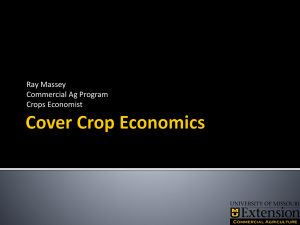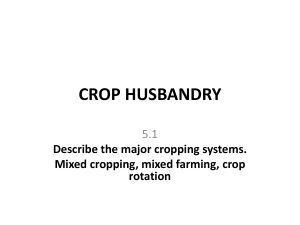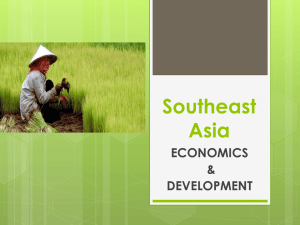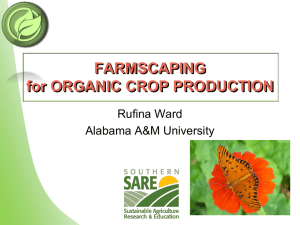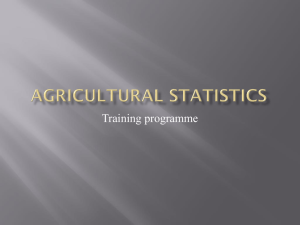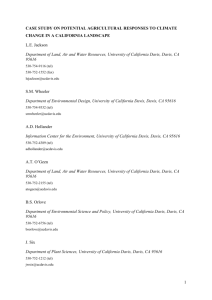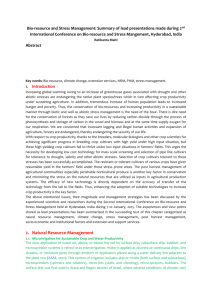here - Department of Real Estate and Construction
advertisement
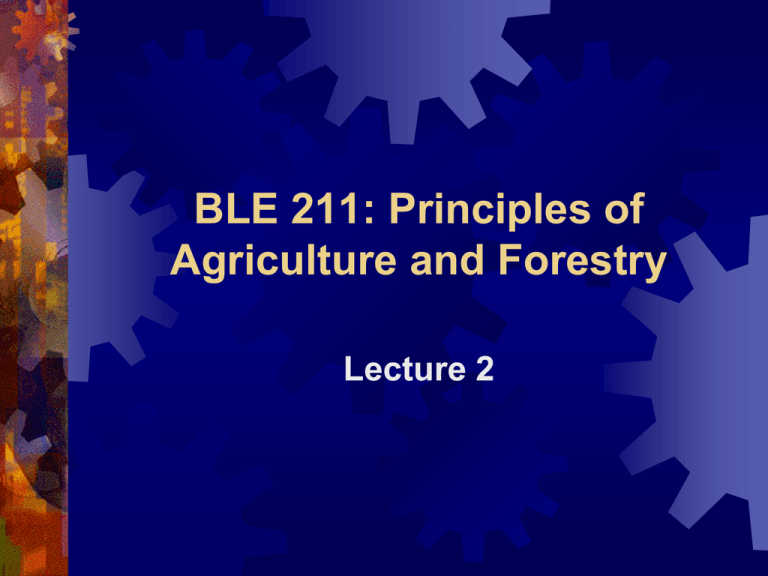
BLE 211: Principles of Agriculture and Forestry Lecture 2 Agricultural Practices Crop production systems vary with the crop, time, location and the level of technology of the particular area. In pre-agricultural societies gathering wild plants was the only way to obtain crop products. The management of natural stands of some useful plant species has continued to play an important role in tropical crop production. Many practices have also evolved with the evolution of man. They may be: Extensive on large areas of land or Intensive in gardens. Agricultural practices involve the use of choice cultivars and manipulations of soil and other resources to obtain desired yields from plants Types of Cultivation practices Shifting cultivation: With increased population, shifting cultivation has been replaced by sedentary occupation and reduced length of fallow period. Mono-cropping: This is the growing one crop to maturity on a piece of land. Not common in the tropics except in plantations and swamp rice, sugarcane or large-scale maize production. Mixed-cropping or multiple cropping: It is growing of two or more crops on the same piece of land, simultaneously. Most common of the farming practices in the tropics usually associated with under-developed farm technology. Crop Rotation: A given combination of crops is grown in a particular sequence on the same piece of land for several years without loss of soil fertility or reduced yields Types of Mixed cropping Inter-cropping: Short-term annuals planted through long-term annuals or biennials and harvested before the main crop matures. Inter-planting: Long-term annual or biennial crops planted through short-term annuals. Phased Planting: Planting dates are systematically arranged to ensure continuous sequence of growth and harvesting. Relay Planting: Following one crop with another immediately before harvesting the former crop. Advantages of Mixed Cropping Reduces susceptibility to diseases and pests as well as risks of crop failure. Allows for adaptation of plants to changing soil conditions because of differences in peak demand by associated crops for nutrients and water. Facilitates vertical and horizontal variations thus allowing cultivation of crops adapted to light and shade. Permits phased harvesting and even distribution of workload Provides reasonable soil cover that protects the soil against erosion, while suppressing weed growth. Provides higher yields that mono-cropping Adaptable to small-scale hand operated farming Principles of Crop Rotation Alternate growing of crops with differential ability to absorb nutrients from the soil or having different depths of rooting system. Alternating crops susceptible to certain diseases with those that are resistant. A Planned succession of crops that takes into account any detrimental or beneficial effects of one crop on the following crop. Alternating soil-exhausting crops with crops that contribute to the improvement of soil fertility. Alternating crops with peak requirements of labour, water etc. Agricultural Systems Characteristics Reducing farm sizes although some large-scale farms are still in existence. Use of human labour and simple tools. Animal power limited to only a few operations. Permanent cultivation usually restricted to homestead and to tree crops but with increasing population permanent cultivation especially on flood plains and other productive soil regions is emerging. Mixed cropping is widespread. There are usually more crops and crop combinations on the homestead farms than on outlying farms. Cropping is almost entirely dependent on rainfall. Irrigation is mainly practised for the high-value cash crops. Agricultural Systems Characteristics Burning is widely used as a means of clearing the land in preparation for planting. Limited use of manufactured chemical fertilisers due to cost. Soil fertility is maintained through regular fallowing or application of household and animal refuse. Animals, especially poultry are kept on free range. Farm animals are fed on fodder while kitchen wastes provide food for a few animals kept in the household. Extensive animal husbandry relies on continuous movement of livestock in search of forage and water throughout the year. Low level of capital investment since primary objective of most farmers is subsistence. Agricultural Systems Characteristics With the increase in availability of industrial consumer goods, the traditional objective of self-sufficiency in food is gradually giving way to an exchange economy. In this economy the level of capital investment in farming determines to some extent the level of income and ability of the farmer to acquire consumer goods. Changes in Agricultural Systems Shifting cultivation has been considerably modified resulting in more settled land occupation as opposed to constant migration by cultivators. Nomads continue to move with their animals particularly cattle, sheep, goats and camels, in search of grazing Intensive production of poultry and pigs is practised. Dairying as an intensive practice and ranching as an extensive practice are also found in the tropics. Changes in Agricultural Systems With the development of large-scale and small-scale irrigation projects, arable farming of cereal, vegetable crops, fruits and flowers has gradually developed. Large-scale, arable, rain-fed as well as tree-crop plantation has been developed in the more humid areas in response to market demands for industrial and food crops. Intensive production of vegetables, fruits and flowers has increased tremendously. Reasons for these Changes Increase of human population, which impose a greater demand for food and other agricultural products. Rapid urbanisation attracts labour away from agriculture and encourages intensification. Technical progress raising the demand for agricultural raw materials and Changed outlook of farmers from subsistence to commercial production aimed at maximisation of income. Branches of Agriculture Animal science: This is concerned with the study of animal breeding and husbandry including aspects of animal health. Crop Science: The study of crops, their management, harvesting and storage. Soil Science: The study of the classification survey, conservation and management of the soil for crop and animal production. Mechanisation - The study of agricultural machinery and tools together with the development of improved implements and methods of managing crops, animals and their products. Horticulture – This is the study of cultivation of fruits, vegetables and ornamental plants. Branches of Agriculture Forestry: Science of forest resources and their management and conservation as well as utilisation of forest and forestry products. Wildlife and range management - Concerned with the study of wildlife resources in the forest ecosystem. Fisheries - study of the wildlife resources of aquatic systems. Agricultural economics - Demand-and-supply relationships in agriculture and the economics of agricultural production including financing, land tenure, marketing of agricultural products, co-operatives, project development and evaluation. Agricultural extension and Rural Sociology - Development and dissemination of agricultural information; the transfer of technology to farmers and the study of the lifestyles of rural farming populations.


